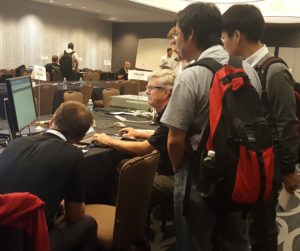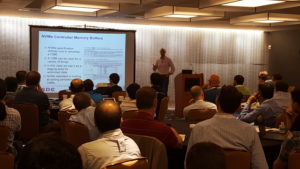Category: file storage
Virtualization and Storage Networking Best Practices from the Experts
 Ever make a mistake configuring a storage array or wonder if you’re maximizing the value of your virtualized environment? With all the different storage arrays and connectivity protocols available today, knowing best practices can help improve operational efficiency and ensure resilient operations. That’s why the SNIA Networking Storage Forum is kicking off 2019 with a live webcast “Virtualization and Storage Networking Best Practices.”
In this webcast, Jason Massae from VMware and Cody Hosterman from Pure Storage will share insights and lessons learned as reported by VMware’s storage global services by discussing: Read More
Ever make a mistake configuring a storage array or wonder if you’re maximizing the value of your virtualized environment? With all the different storage arrays and connectivity protocols available today, knowing best practices can help improve operational efficiency and ensure resilient operations. That’s why the SNIA Networking Storage Forum is kicking off 2019 with a live webcast “Virtualization and Storage Networking Best Practices.”
In this webcast, Jason Massae from VMware and Cody Hosterman from Pure Storage will share insights and lessons learned as reported by VMware’s storage global services by discussing: Read More
File, Block and Object Storage: Real-world Questions, Expert Answers
File vs. Block vs. Object Storage – Are Worlds Colliding?
 When it comes to storage, a byte is a byte is a byte, isn’t it?
One of the enduring truths about simplicity is that scale makes everything hard, and with that comes complexity. And when we’re not processing the data, how do we store it and access it? Read More
When it comes to storage, a byte is a byte is a byte, isn’t it?
One of the enduring truths about simplicity is that scale makes everything hard, and with that comes complexity. And when we’re not processing the data, how do we store it and access it? Read More
Does Your World Include Storage? Don’t Miss SDC!
Whether storage is already a main focus of your career or may be advancing toward you, you’ll definitely want to attend the flagship event for storage developers – and those involved in storage operations, decision making, and usage – SNIA’s 19th annual Storage Developer Conference (SDC), September 11-14, 2017 at the Hyatt Regency Santa Clara, California. Read More
An FAQ to Make Your Storage System Hum
SNIA Activities in Security, Containers, and File Storage on Tap at Three Bay Area Events
SNIA will be out and about in February in San Francisco and Santa Clara, CA, focused on their security, container, and file storage activities.
 February 14-17 2017, join SNIA in San Francisco at the RSA Conference in the OASIS Interop: KMIP & PKCS11 booth S2115. OASIS and SNIA member companies will be demonstrating OASIS Key Management Interoperability Protocol (KMIP) through live interoperability across all participants. SNIA representatives will be on hand in the booth to answer questions about the Storage Security Industry Forum KMIP Conformance Test Program, which enables organizations with KMIP implementations to validate the protocol conformance of those products and meet market requirements for secure, plug-and-play storage solutions. And Eric Hibbard, Chair of the SNIA Security Technical Work Group and CTO Security and Privacy, HDS Corporation, will participate in the “Can I Get a Witness? Technical Witness Bootcamp” session on February 17.
February 14-17 2017, join SNIA in San Francisco at the RSA Conference in the OASIS Interop: KMIP & PKCS11 booth S2115. OASIS and SNIA member companies will be demonstrating OASIS Key Management Interoperability Protocol (KMIP) through live interoperability across all participants. SNIA representatives will be on hand in the booth to answer questions about the Storage Security Industry Forum KMIP Conformance Test Program, which enables organizations with KMIP implementations to validate the protocol conformance of those products and meet market requirements for secure, plug-and-play storage solutions. And Eric Hibbard, Chair of the SNIA Security Technical Work Group and CTO Security and Privacy, HDS Corporation, will participate in the “Can I Get a Witness? Technical Witness Bootcamp” session on February 17.
 The following week, February 21-23, join SNIA at Container World in Santa Clara CA. Enabling access to memory is an important concern to container designers, and Arthur Sainio, SNIA NVDIMM Special Interest Group Co-Chair from SMART Modular, will speak on Boosting Performance of Data Intensive Applications via Persistent Memory. Integrating containers into legacy solutions will be a focus of a panel where Mark Carlson, SNIA Technical Council Co-Chair from Toshiba, will speak on Container Adoption Paths into Legacy Infrastructure. SNIA experts will be joined by other leaders in the container ecosystem like Docker, Twitter, ADP, Google, and Expedia . The SNIA booth will feature cloud infrastructure and storage discussions and a demonstration of a multi-vendor persistent memory solution featuring NVDIMM! (P.S. – Are you new to containers? Get a head start on conference discussions by checking out a December 2016 SNIA blog on Containers, Docker, and Storage.)
The following week, February 21-23, join SNIA at Container World in Santa Clara CA. Enabling access to memory is an important concern to container designers, and Arthur Sainio, SNIA NVDIMM Special Interest Group Co-Chair from SMART Modular, will speak on Boosting Performance of Data Intensive Applications via Persistent Memory. Integrating containers into legacy solutions will be a focus of a panel where Mark Carlson, SNIA Technical Council Co-Chair from Toshiba, will speak on Container Adoption Paths into Legacy Infrastructure. SNIA experts will be joined by other leaders in the container ecosystem like Docker, Twitter, ADP, Google, and Expedia . The SNIA booth will feature cloud infrastructure and storage discussions and a demonstration of a multi-vendor persistent memory solution featuring NVDIMM! (P.S. – Are you new to containers? Get a head start on conference discussions by checking out a December 2016 SNIA blog on Containers, Docker, and Storage.)
 Closing out February, find SNIA at their booth at USENIX FAST from February 27-March 2 in Santa Clara, CA, where you can engage with SNIA Technical Council leaders on the latest activities in file and storage technologies.
Closing out February, find SNIA at their booth at USENIX FAST from February 27-March 2 in Santa Clara, CA, where you can engage with SNIA Technical Council leaders on the latest activities in file and storage technologies.
We look forward to seeing you at one (or more) of these events!
SNIA Storage Developer Conference-The Knowledge Continues
SNIA’s 18th Storage Developer Conference is officially a success, with 124 general and breakout sessions; Cloud Interoperability, Kineti c Storage, and SMB3 plugfests; ten Birds-of-a-Feather Sessions, and amazing networking among 450+ attendees. Sessions on NVMe over Fabrics won the title of most attended, but Persistent Memory, Object Storage, and Performance were right behind. Many thanks to SDC 2016 Sponsors, who engaged attendees in exciting technology discussions.
c Storage, and SMB3 plugfests; ten Birds-of-a-Feather Sessions, and amazing networking among 450+ attendees. Sessions on NVMe over Fabrics won the title of most attended, but Persistent Memory, Object Storage, and Performance were right behind. Many thanks to SDC 2016 Sponsors, who engaged attendees in exciting technology discussions.
For those not familiar with SDC, this technical industry event is designed for a variety of storage technologists at various levels from developers to architects to product managers and more. And, true to SNIA’s commitment to educating the industry on current and future disruptive technologies, SDC content is now available to all – whether you attended or not – for download and viewing.
 You’ll want to stream keynotes from Citigroup, Toshiba, DSSD, Los Alamos National Labs, Broadcom, Microsemi, and Intel – they’re available now on demand on SNIA’s YouTube channel, SNIAVideo.
You’ll want to stream keynotes from Citigroup, Toshiba, DSSD, Los Alamos National Labs, Broadcom, Microsemi, and Intel – they’re available now on demand on SNIA’s YouTube channel, SNIAVideo.
All SDC presentations are now available for download; and over the next few months, you can continue to download SDC podcasts which combine audio and slides. The first podcast from SDC 2016 – on hyperscaler (as well as all 2015 SDC Podcasts) are available here, and more will be available in the coming weeks.
SNIA thanks all its members and colleagues who contributed to make SDC a success! A special thanks goes out to the SNIA Technical Council, a select group of acknowledged industry experts who work to guide SNIA technical efforts. In addition to driving the agenda and content for SDC, the Technical Council oversees and manages SNIA Technical Work Groups, reviews architectures submitted by Work Groups, and is the SNIA’s technical liaison to standards organizations. Learn more about these visionary leaders at http://www.snia.org/about/organization/tech_council.
And finally, don’t forget to mark your calendars now for SDC 2017 – September 11-14, 2017, again at the Hyatt Regency Santa Clara. Watch for the Call for Presentations to open in February 2017.
Clustered File Systems: No Limits
Today’s storage world would appear to have been divided into three major and mutually exclusive categories: block, file and object storage. The marketing that shapes much of the user demand would appear to suggest that these are three quite distinct animals, and many systems are sold as exclusively either SAN for block, NAS for file or object. And object is often conflated with cloud, a consumption model that can in reality be block, file or object.
A fixed taxonomy that divides the storage world this way is very limiting, and can be confusing; for instance, when we talk about cloud. How should providers and users buy and consume their storage? Are there other classifications that might help in providing storage solutions to meet specific or more general application needs? What about customers who need file access performance beyond what one storage box can provide? Which options support those who want scale-out solution like object storage with file protocol semantics?
To clear up the confusion, the SNIA Ethernet Storage Forum is hosting a live Webcast, “Clustered File Systems: No Limits.” In this Webcast we will explore clustered storage solutions that not only provide multiple end users access to shared storage over a network, but allow the storage itself to be distributed and managed over multiple discrete storage systems. You’ll hear:
- General principles and specific clustered and distributed systems and the facilities they provide built on the underlying storage
- Better known file systems like NFS, IBM Spectrum Scale (GPFS) and Lustre, along with a few of the less well known
- How object based systems like S3 have blurred the lines between them and traditional file based solutions
This Webcast should appeal to those interested in exploring some of the different ways of accessing & managing storage, and how that might affect how storage systems are provisioned and consumed. POSIX and other acronyms may be mentioned, but no rocket science beyond a general understanding of the principles of storage will be assumed. Contains no nuts and is suitable for vegans!
As always, our experts will be on hand to answer your questions on the spot. Register now for this October 25th event.
Linear Tape File System Now an International Standard
By David Pease, Co-Chair SNIA Linear Tape File System Technical Working Group
In 2011 the Linear Tape File System (LTFS) earned IBM an Engineering Emmy Award after being recognized by FOX Networks for “improving the ability of media companies to capture, manage and exploit content in digital form, fundamentally changing the way that audio and video content is managed and stored.” Now, the International Standardization Organization (ISO) has named LTFS an International Standard (ISO/IEC 20919:2016).
LTFS’s road to standardization was a long one. It started with IBM and the LTO (Linear Tape Open) Consortium jointly publishing the LTFS Format Specification as an open format in April, 2010, the day that LTFS was announced at the NAB (National Association of Broadcasters) show in Las Vegas. In 2012, at the invitation of the Storage Networking Industry Association (SNIA), we formed the SNIA LTFS Technical Work Group, with a specific goal of moving towards international standardization. The LTFS TWG and SNIA proceeded to publish several revisions of the LTFS Format Specification, inviting all interested parties to join the work group and contribute, or to comment on the specification before formal publication. In 2014 SNIA helped the LTFS TWG format the then-current version of the specification (V2.2) to ISO standards and worked with the ISO organization to publish the specification as a draft standard and solicit comments. After review and comments, the LTFS Format Specification was approved by ISO as an international standard in April of 2016 (just 6 years after it was first announced).
We are thrilled by the recognition of LTFS as an ISO standard; it is one more step towards guaranteeing that the LTFS format is a truly open standard that will continue to be available and usable for the foreseeable future. In my opinion, two of the major inhibitors to the widespread use of tape technology for data storage have been the lack of a standard format for data storage and interchange on tape, and its perceived difficulty of use. LTFS addresses both of these problems by providing a general-purpose, open format that can easily be used like any other storage medium.
As the world’s data continues to grow at an increasing pace, and the need for affordable, large-scale storage becomes more important, the standardization of LTFS will make the use of tape for long-term, affordable storage easier and more attractive.
Use Case: Making Digital Media Storage Open and Future-Proof
Just as in personal photography, the last couple of decades have seen a major shift from analog and film technologies to digital ones in the Media and Entertainment industry, where modern cameras record directly to digital media. This has led to the need for new technologies to replace traditional film as a long-term storage medium for television and movies.
Film has some specific advantages for the Media & Entertainment industry that a new technology needs to replicate, including long shelf life, inexpensive, and zero-power storage, and a format that is “future-proof.” Tape storage is a perfect match to several of these criteria, including long (30+ years) shelf life, and zero-power, inexpensive storage. However, a stumbling block for the wide-spread acceptance of tape for digital storage in the media and entertainment business had been the lack of an open, easy-to-use, future-proof standard for the format of the data on tape. You can imagine an entertainment company using proprietary storage software, for example, only to run into problems like the provider going out of business or increasing its software costs to an unacceptable level.
We created LTFS to be an open and future-proof format from the beginning: open, because when we published the format, we made it publicly available at no charge, and future-proof because the format is self-documenting and can be easily accessed without the need for proprietary software.
Being an international standard should make anyone who is considering the use of LTFS even more comfortable with the fact that it is an open standard that is not owned or controlled by any single company, and is a format that will continue to be supported in the future. As such, becoming an international standard has the potential to increase the use, and therefore the value, of LTFS across industries.
For more information about the work of the SNIA LTFS TWG, please visit www.snia.org/ltfs.